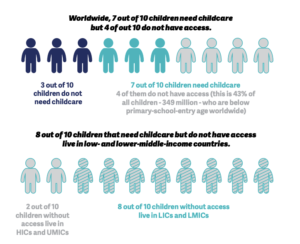March marked one year since the start of the pandemic. One full year during which many of us have become intimately familiar with the challenges of caring for our children while we are working. We have struggled to give our children the attention they need to thrive while also being productive in our work. For 40% of the world’s children, this is an everyday reality, not simply a COVID reality.

We know this thanks to a new landmark report from the World Bank, which estimates that 349 million children need childcare but do not have access to it. 80% of these children live in low and middle income countries.
A second report published this month by the International Development Research Centre (IDRC) underscores how the childcare crisis has gotten worse because of COVID-19. Women worldwide are spending 30 hours a week on childcare, and the load is even greater for low-income women. As a consequence, adolescent girls are shouldering even more of the childcare burden, putting their re-entry to school at risk.
What if one intervention could help give young children a stimulating learning environment during the critical early years of brain development and help narrow gender gaps in education for adolescents? What if that same intervention could create millions of jobs, improve women’s employment and productivity, and boost overall economic growth and development?
Expanding access to quality, affordable childcare is a strategic investment that can yield all of these benefits. These two reports make a strong case for government investment in childcare and the importance of these investments for an inclusive and gender-responsive recovery from COVID-19. The World Bank paper highlights the many different sectors and policy instruments that can serve as an entrypoint for investing in childcare — and emphasizes the importance of ensuring quality and prioritizing vulnerable families. For more on this topic and another take on these latest reports, check out Joan Lombardi and Megan O’Donnel’s arguments for why It’s Time to Invest in Global Childcare.
——-
In other news this month, a report by Save the Children estimates that children worldwide have lost, on average, one-third of a school year as a result of COVID-19. Another recent study, drawing on longitudinal data in Ghana, estimates that a three-month transition period from Complementary Basic Education to government schools resulted in a loss of 66% of previous learning gains in foundational numeracy. Students without home learning support or resources lost even more of their learning gains. This underscores the dramatic implications of school closures — which may get even worse as another wave of COVID forces schools to remain closed or re-close in countries like Kenya.
In the face of devastating learning losses built on top of an already existing learning crisis, how should the global education architecture move forward? Girindre Beeharry of the Gates Foundation published an essay arguing that we need to focus on a few priorities — notably foundational literacy and numeracy — measure whether we are making progress, and hold ourselves accountable for doing so. He argues that we have been putting too much emphasis on calling for more money to education (given that the level of funding being advocated cannot plausibly be met) and too little energy rallying behind clear and explicit priorities (because there is not enough money, prioritization is implicitly happening all the time, we may as well make it explicit). If you’d prefer to listen to his argument, check out Girindre’s interview on the FreshEd podcast.
Speaking of podcasts, did you catch the launch of not one but TWO new podcasts dedicated to girls’ education? Teach for All’s Samantha Williams hosts the Inside Global Girls’ Education podcast, and the UN Girls’ Education Initiative launched a podcast, too. While you’re on UNGEI’s (new) website, check out their new Knowledge Hub with resources on girls’ education.
Last, but certainly not least, did you hear about the parade of echidnas deployed to Egypt (yes, a group of echidnas is called a “parade”!)? Their natural burrowing skills were instrumental in loosening the dirt to release the giant ship that was stuck for a full week in the Suez Canal. Check them out!
